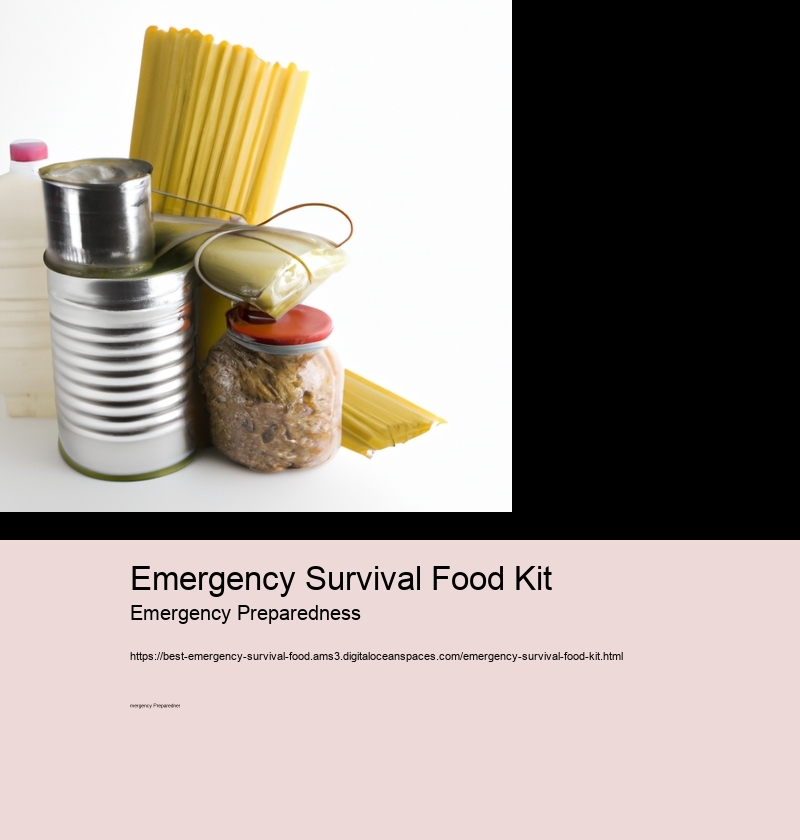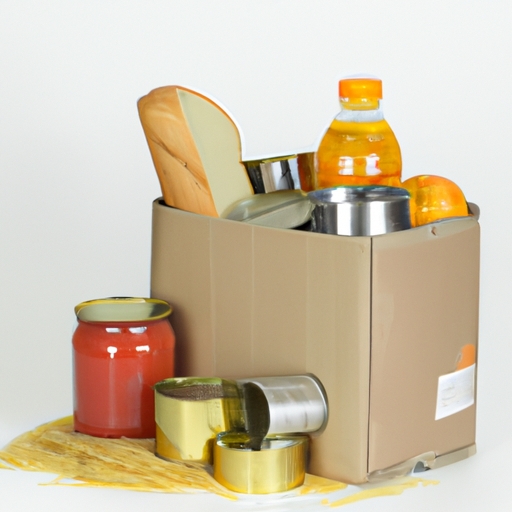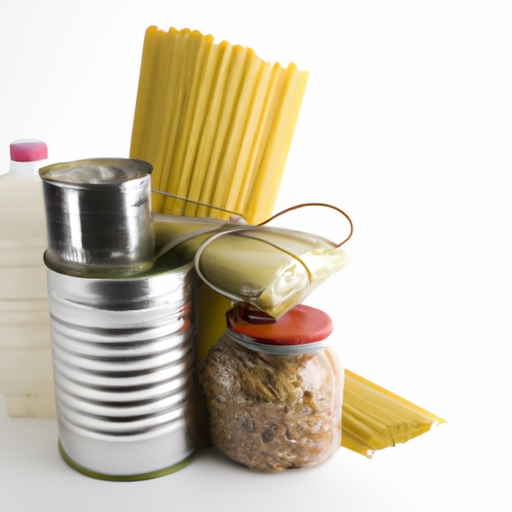Emergency Survival Food Kit
Introduction

Introduction
Introdution of an Emergency Survival Food Kit!
Nobody likes to think 'bout disasters, (especially when they strike) but being prepared is the best way to protect yourself and your family. An emergency survival food kit is one great way to ensure you have enough sustenance in case of a natural disaster or any other type of crisis.
Moreover, having a stocked kit in hand can be a real lifesaver. It provides essential nutrition for those facing trying times. A good quality kit should include non-perishable, ready-to-eat items like canned foods, freeze-dried meals, nuts and seeds that can provide you with energy during an emergency situation. Furthermore, it's important to make sure that these items are within their expiration dates so they remain safe and nutritious for consumption.
In addition, water is also vital for survival and most kits will contain several gallon jugs or pouches filled with purified drinking water. Additionally, always check if the package contains any perishable items such as dairy products or refrigerated goods since these must be kept cold at all times.
Finally, another key point is to remember that an emergency food supply should never replace daily meals; rather it's meant to supplement them in case of unexpected events. With this mindset in mind it becomes easier to select the right type of food kit that suits your needs!
To conclude, an emergency survival food kit can be crucial during tough times and by taking the necessary steps you can give yourself peace of mind knowing your loved ones are well taken care off!
Types of Emergency Survival Food Kits
Emergency survival food kits can be a life-saving asset in times of need! These kits typically include ready-to-eat meals that are designed to last for many years. There are several types available, each with their own advantages and disadvantages.
One type is freeze-dried foods, which have been dehydrated at low temperatures to reduce their moisture content. This makes them lightweight and easy to transport, but they require the addition of hot water before consumption. Furthermore, their shelf life can range from 5-25 years depending on the product.
Another option is MREs or Meal Ready-To Eat. These come pre-packaged and don’t require any preparation prior to consuming them; however, they tend to be more expensive than other varieties. Plus, since they're not really intended for long term storage, their lifespan is usually only 3–5 years.
Finally, there are canned goods such as beef jerky or tuna which can provide sustenance in an emergency situation. Although these items may not taste great over time due to oxidation, they can remain fresh for up 20 yeas if stored properly! The main downside is that these cans are often quite heavy so aren’t ideal for trekking or hiking trips.
In conclusion, when it comes to emergency survival food kits there are many choices available based on individual needs and preferences. It's important to evaluate each one carefully before making a purchase so that you know you will have the best option in case of an unexpected event!
Benefits of Having a Survival Food Kit
Survival food kits can be a lifesaver in an emergency situation! They provide essential nutrition and energy to keep us going, (and) are extremely compact and lightweight. Not only that, but they have numerous other benefits too! Firstly, they can save you money in the long run as you don't need to purchase all the ingredients separately. Secondly, it's much easier to store these kits than individual items; they're lightweight and take up less space. Thirdly, most survival food kits come with a shelf-life of up to 25 years - so you can rest assured knowing your supplies will last for a while!
Moreover, having a survival food kit gives you peace of mind knowing that if something were to happen suddenly such as natural disasters or political unrests that could affect access to fresh food sources, you'd still have something nutritious available. It also allows you to prepare meals quickly without having to worry about hunting or gathering for sustenance. Furthermore, some of these kits contain freeze-dried fruits and vegetables which help provide vital vitamins and minerals in our diet.
To sum up, having an emergency survival food kit is certainly worthwhile considering all the advantages it offers. From saving money by buying ingredients in bulk, providing quick meal solutions during emergencies or just giving us peace of mind knowing we have something nutritious on hand - there are countless benefits! So why not invest in one today?
Considerations When Choosing an Emergency Survival Food Kit
When it comes to selecting an emergency survival food kit, there are many considerations that must be taken into account. Firstly, the size of the kit is important; too big and it can become difficult to carry, too small and you won't have enough sustenance for a prolonged period of time. Secondly, think about what type of food will be most beneficial; preserveable foods such as dried fruit and nuts, or canned goods which can last longer? Additionally, consider if you'll need utensils like plates and cutlery - this could save on valuable weight.
Moreover, don't overlook health factors! Ensure that any foods included offer nutritionally balanced meals that provide essential vitamins and minerals. Also look at how long the storage life is; some items may not stay fresh for very lengthy periods of time so check expiration dates carefully! Finally, cost should be considered (especially if on a budget) but don't let price tag to be the main deciding factor when choosing an emergency survival food kit. After all, your safety should come first!
In conclusion, these are just some ponderings that ought to be taken into consideration when selecting an emergency survival food kit. Though daunting at first glance; research your options thoroughly beforehand and make sure you pick something which meets all of your requirements!
How to Store an Emergency Survival Food Kit
Storing an emergency survival food kit is essential(!) if you want to be prepared for any disasters. In order to keep your supplies fresh and safe, there are several steps that must be taken. First, it is important to locate a cool, dry area of your house or apartment where you can store the kit. It’s best to avoid areas such as garages or attics which could become too warm during hot weather. Additionally, make sure the place isn't accessible by kids and pets.
Next, ensure all the items in your kit are sealed properly in airtight containers or bags. This will prevent moisture from entering them and also help protect against critters getting inside. You should also inspect each item before storing them and discard any expired items immediately!
Furthermore, it's advisable to label everything with the expiration dates clearly written on them so you know when they need replacing. It's also wise to rotate your stock every few months so that it doesn't get forgotten about and remain unused for long periods of time. Finally, consider keeping a list of all items included in your emergency food kit somewhere visible so you always know what needs replenishing quickly if needed!
Overall, by following these key tips for storing an emergency survival food kit successfully (!), you can rest assured knowing that you have the supplies and knowledge necessary when disaster strikes.
Nutritional Content of Emergency Survival Food Kits
Emergency Survival Food Kits are an important tool for staying alive in a crisis situation. They provide not only sustenance, but also nutritional content to help support our bodies during times of stress and trauma. (It) is essential that the food be as nutritious as possible when choosing an emergency survival food kit!
The most nutritionally sound kits will contain items such as grains, legumes, vegetables, fruits, nuts and seeds. These foods can provide the body with complex carbohydrates, proteins, fats and vitamins necessary to maintain health. It is best if these items are freeze-dried or dehydrated so that they retain their nutritive value even after long periods of storage. Additionally, some kits may include processed food items like energy bars which often have added nutrients like vitamin C or iron to further enhance their nutritional content.
However, it is still important to check the labels on any prepared meals or snacks before purchasing a kit. Make sure that there are no preservatives or chemicals which could potentially cause harm over extended use; additionally examine the sodium and sugar levels in order to limit potential health risks from consuming too much salt or sugar. Moreover, make certain that all ingredients used within the kit are certified organic and non-GMO so you can trust what you're eating!
Furthermore, always strive for variety when selecting your emergency survival food kit - this way you avoid getting bored with whatever's available while ensuring your dietary needs aren't neglected in any way. Above all else remember: nutrition matters greatly during times of crisis! Transition phrase: To sum up...
To sum up, it is important to pay close attention to the nutritional content of emergency survival food kits - both in terms of quality and quantity - before making a purchase! Not only will this ensure optimal nourishment during an emergency situation; it will also give you peace of mind knowing that what you're consuming is safe for long-term consumption!
Common Questions About Emergency Survival Food Kits
Emergency survival food kits are essential for any situation that may arise where you need to be prepared. They provide sustenance for those in emergency situations, and can help ensure an individual's safety during times of crisis. (However,) It is important to know what kind of emergency survival food kit will work best for your needs. There are many common questions about these kits, which we will discuss here!
First off, do I need an emergency survival food kit? Absolutely! An emergency situation can happen at anytime and having a kit ready with all the supplies you need is crucial. Even if it's just a simple storm or power outage, having a kit on hand could be lifesaving.
Next, how long should my emergency food supply last? This depends on the type of kit you purchase and the size of your family. Generally speaking, the average person needs about 2000 calories per day to survive. A good rule of thumb is to make sure your supply lasts at least three days per person in your household - although it is recommended that you have enough for up to two weeks in case of an extended period without access to other food sources!
Another question often asked is: What kind of foods should I include in my emergency supplies? Non-perishable items such as canned goods, dried fruit and nuts are great options as they won't spoil easily and can provide plenty of energy when needed most. Additionally, consider adding some comfort foods like chocolate or candy bars which can help boost morale during tough times!
(Moreover,) Can I use my own containers instead of buying pre-made kits? Yes - but take caution when doing so! Be sure to check expiration dates on any canned goods before packing them into your container; otherwise they may not be safe to eat after a few months or so has passed since their purchase date. Additionally, make sure all containers are airtight and secure so no moisture or pests get inside!
Finally, Is it necessary to rotate out my supply every so often? Yes - it is important to check expiration dates regularly and replenish items as needed in order for them to remain effective in an emergency situation. Rotating out old items helps keep your supplies fresh and ensures that you'll have everything you need when disaster strikes!
In conclusion ,emergency survival food kits can give peace of mind knowing that if something were ever occur suddenly ,you would have sustenance readily available .By taking time now answer common questions regarding these types of kits ,you'll be more prepared for whatever comes next !
Conclusion
Emergency survival food kits are an essential part of any disaster preparedness plan. Without them, you may find yourself in a difficult situation when the unexpected happens. A good emergency food kit should include non-perishable items that have a long shelf life and don't require refrigeration or cooking, such as canned goods, nuts, dried fruit and energy bars. It's also important to store enough water for drinking and sanitation purposes. (Don't forget to include utensils and other basic supplies like matches.)
In conclusion, having an emergency survival food kit is critical for being prepared in case of an unforeseen disaster. You want to ensure you have enough food to sustain your family (and pets) during these times! Make sure that whatever kit you choose has a variety of nutritious items with a long shelf life - it could be the difference between life and death! Additionally, don't forget key supplies such as water and utensils. All in all, having an emergency survival food kit is essential for surviving in tough situations!
But remember - take into account the number of people in your household when purchasing one so there's enough food to go around. Plus, double-check expiration dates on all perishable items regularly!!

